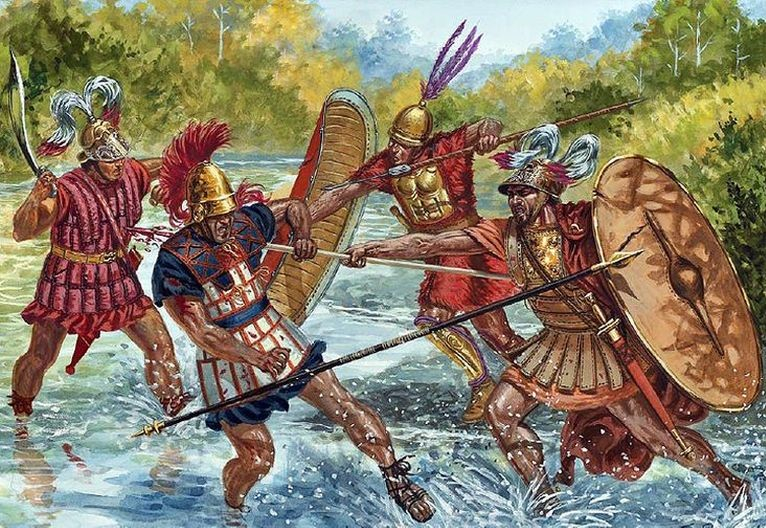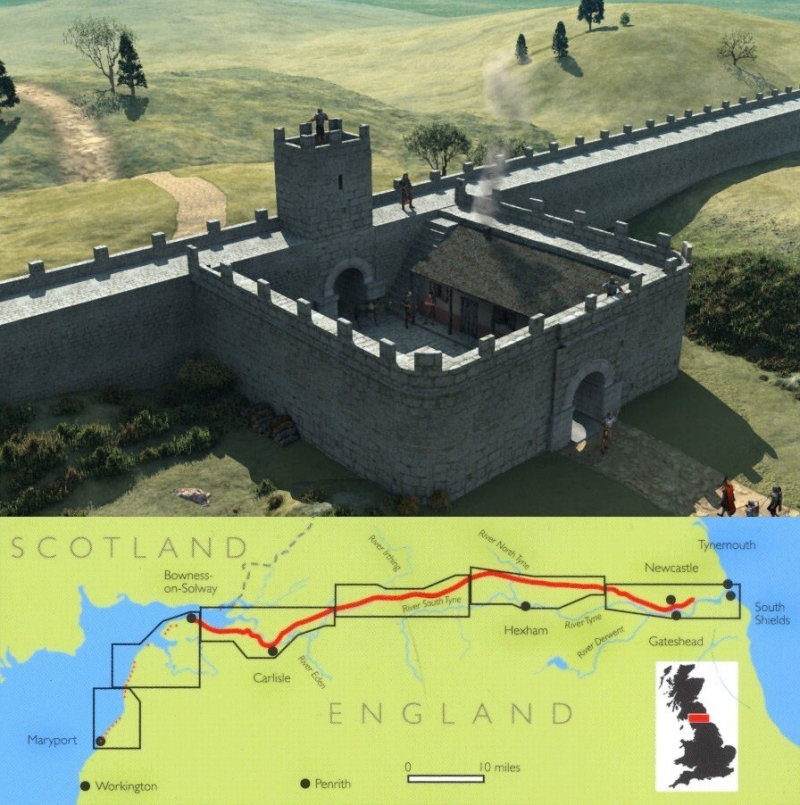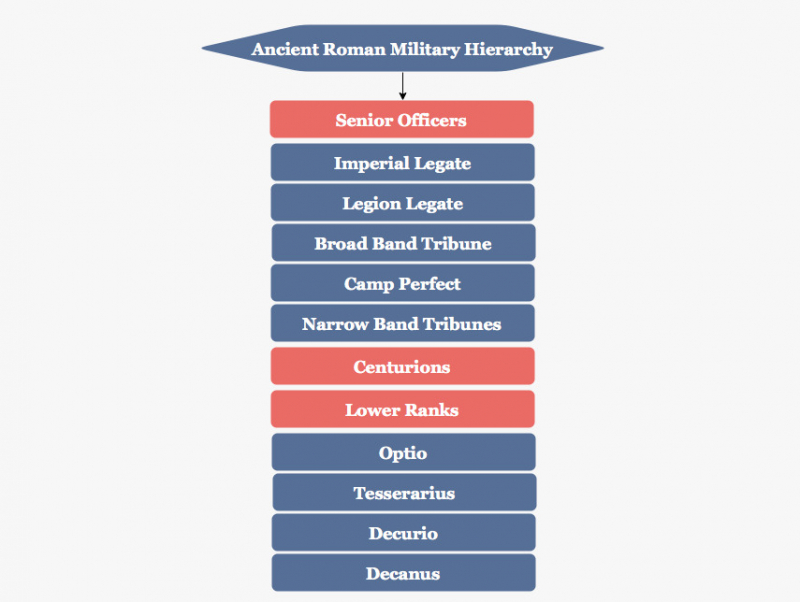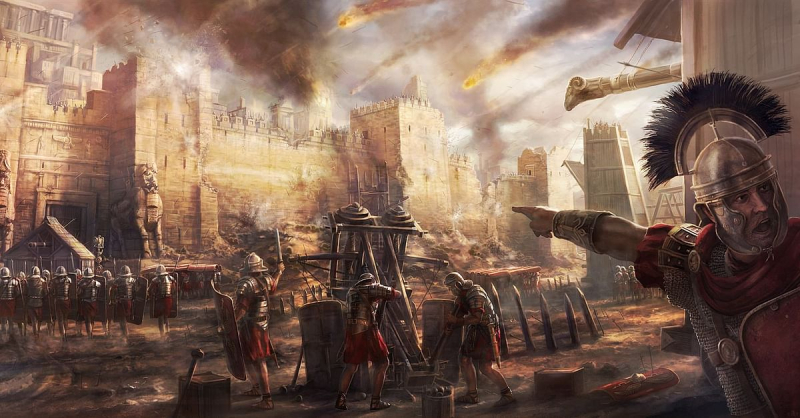Top 10 Things to Know about Ancient Roman Army
The Roman Army was established in 753 BCE, and it lasted until 1453 CE. As a result, it persisted for more than 2,000 years. It experienced several ... read more...permutations and combinations throughout this time with regard to composition, organization, equipment, and tactics. The Roman army was the most formidable and potent military force in prehistoric times. At its height, it had some 500,000 warriors and ruled over a vast empire, taking over large portions of the ancient globe from Britain to the Middle East. Here are the 10 Things to Know about the Ancient Roman Army.
-
The early Roman army consisted of the armies of the early Roman Republic and the early Roman Kingdom. From 500 BC to 300 BCE, the Early Roman army was based on an annual levy. During this time, it has been argued that the army used Etruscan or Greek organizational and technological models at this time when fighting mostly consisted of small-scale raids for loot.
At the beginning of each campaigning season, when war was proclaimed, adult male citizens were required to pay a levy, which served as the foundation for the early Roman army. There were no professional or permanent forces. The usual levy during the Regal Era (until around 500 BC) was roughly 9,000 men, made up of 2,400 light-armed infantry (Rorarii, afterward termed Velites), 600 light cavalry, and 6,000 fully armed infantry (possibly Greek-style hoplites) (Equites Celeres). The standard levy retained the same size when the monarchs were replaced by two dually chosen praetores in around 500 BC, but it was now evenly divided between the Praetors, who each commanded one legion of 4,500 men.
The Romans continued to use the levy system throughout the Mid-Republic Period (300 BC–88 BCE), but they also adopted the manipular structure for their legions beginning with the Velites, the Hastati, the Principes, and the Triarii. In contrast to the maximum 6-year tenure of conscripts, a rising proportion of recruits during the Late Republic Period (88 to 30 BCE) joined up as volunteers for 16-year periods. The short-term levy system was completely replaced in Imperial Rome (30 BCE - 284 CE) by a standing professional army made up primarily of volunteers who served conventional 20-year terms in addition to five years as reservists. However, many remained on active duty for up to 30 to 40 years.
The Late Roman military era spans from (284–476 AD). The Ancient Roman Army resumed regular yearly conscription of citizens during this era, which was culminated by the reforms of the emperor Diocletian (reigned 284–305 AD), while also accepting a sizable number of non-citizen barbarian volunteers. However, troops did not rejoin the Republic's temporary levies. Citizens and non-citizens now serve in the same units, replacing the previous split organization of auxiliary and legions. Cohorts or even smaller groups were formed from the former legions. At the same time, a sizeable component of the army's effectiveness was deployed as comitatus presentable, forces that accompanied the emperors, throughout the interior of the empire.

Weapons and Warfare of Early Roman army - Photo: digitalmapsoftheancientworld.com How Roman Infantry Evolved from a Militia to Professional Soldiers? - Video: Epimetheus -
The largest unit of the Ancient Roman Army was the legion. The Latin word "Legio", which ultimately means draft or levy, is where the word "legion" originates. There were initially just four Roman legions. These legions were numbered "I" through "IIII," with "I" rather than "IV" being inscribed for the fourth. The first legion was considered to be the most esteemed. Citizens made up the majority of the army and were assigned to a legion without their choice. By vote, any male from ages 16-46 was chosen and assigned to a legion.
The legion had grown from about 3,000 men in the Roman Republic to more than 5,200 men in the Roman Empire. By the 4th century AD, however, the legion was a much smaller unit of about 1,000 to 1,500 men. A corps is divided into groups of about 500 men. During this time, a typical Roman army had five or six legions. In the Roman army, the rank of the centurion was used. A rank in the Roman army called "Centuria" is comparable to a company in the modern era in terms of size and to a platoon in the modern era in terms of duty. The smallest part of the Roman legion was called "Contubernium". When on a campaign, its troops shared a tent or a barracks bunk room. Each legion was made up of 10 cohorts. In the initial cohort, there had five Centuria of 160 soldiers. The second through tenth cohorts had six Centuria with 80 males. Officers, cavalry, and archers are not among them.
The Romans adopted the Samnite manipular organization for their legions at this time, kept the levy system, and formed a permanent military alliance with all the other peninsular Italian republics. In order to participate in combined forces under Roman leadership, the latter was expected to provide nearly the same number of soldiers. In this period, the same number of allied alae (Roman non-citizen auxiliary), or forces about the size of legions, followed the legions on campaigns.
The Social War (91–88 BC) resulted in the granting of Roman citizenship to all Italians, the abolition of the ancient allied alae, and the incorporation of their members into the legions. The heart of legionary recruiting remained regular yearly conscription, but a rising number of recruits were volunteers who committed to 16-year terms as opposed to the maximum 6-year terms for conscripts. Due to the loss of the ala cavalry, the Roman and Italian legions' ability to provide cavalry cover was diminished by 75%. The legions, which were groups drawn from tribes inside Rome's distant empire and nearby allies tribes, were supplemented by the large-scale growth of native soldiers at this time. In the Roman provinces of Hispania, Gallia, and Thracia, large numbers of heavy infantry and cavalry, as well as archers from the Eastern Mediterranean, were recruited (mostly from Thrace, Anatolia, and Syria). These indigenous forces, however, did not become part of the legions. Instead, they maintained their own distinct leadership, structure, armor, and weaponry.
The Roman Legion - Video: Historia Civilis Top 10 Ancient Roman Legions - Video: Ancient History Lists -
When engaging the enemy, the Roman army is always calculating and cautious rather than a desire for glory in the battles. The generals largely focused on preserving tight formations and safeguarding specific units. A Roman legion was comprised of numerous legionaries or heavy infantry cohorts. One or more attached auxiliary units, which included non-Roman citizens and provided cavalry, were usually present with these. Here is how a war scene featuring the Roman army would generally play out. The initial enemy contact was made by light soldiers. The cavalry was then deployed to act as a shield against encirclement for the center core. As the distance between the contenders shrank, the heavy infantry eventually joined the fight.
Only a small portion of a soldier's life was spent on active duty. They spent most of their time on typical military tasks including training, patrolling, maintaining equipment, etc. Soldiers have a significant impact outside of the military. They served as the equivalent of the police force for the province governor. In addition to building forts and fortified defenses like Hadrian's Wall, they also built roads, bridges, ports, public buildings, brand-new cities (Roman colonies), and engaged in extensive forest clearing and marsh drainage to increase the province's arable land. As a sizable, disciplined, and skilled force of fit men, they played a crucial role in the construction of a province's Roman military and civil infrastructure.
The Roman Legionaries (Elite Heavy Infantryman) - Video: Simple History Why were the Roman Auxiliary Infantry so effective? - Video: Epimetheus -
In order to meet the unique demands of the state during that year, early Rome had a tendency to increase its armies every year. Even while maintaining a standing army may be more effective, such a reactive approach does not show the strong connections between long-term political objectives and the military structure that grand strategy demands.
Famous political scientist Edward Luttwak suggests that the Roman army had the biggest military strategies in history in his book "The Grand Strategy of the Roman Empire". He broke this plan down into three stages. Augustus to Nero was the first period (27 BCE – 68 CE). During this era, Rome's allies formed a buffer along the empire's border, enabling Rome to station its armed troops in key locations. From the Flavians through the Severan emperors was the second period (69 – 235). The Roman Empire was now a fortress with a well-defined boundary. To guarantee peace and prosperity within the empire, the aggressors were dealt with beyond its borders. The final stage lasts from 284 to 305 CE. In this phase, the Romans established preset routes for the attackers to reach their territory and employed point defenses to keep them at bay.

Hadrian's Wall, one of the great strongholds of the ancient Roman Empire to separate the Romans from their enemies - Photo: linkedin.com Video: Sterling Documentaries -
One of the 10 Things to Know about the Ancient Roman Army is that the Roman army was paid depending on their rank. Legionary rankers were relatively well-paid, compared to contemporary common laborers. Compared with their subsistence-level peasant families, they enjoyed considerable disposable income, enhanced by periodic cash bonuses on special occasions such as the accession of a new emperor. In addition, on completion of their term of service, they were given a generous discharge bonus equivalent to 13 years' salary. Meanwhile, the salary that new legionnaires receive viaticum, is usually 3 pieces of gold or 75 denarii while their legionary counterparts received a salary of about 300 denarii.
Early in the first century, auxiliary pay was significantly lower. Auxiliary infantrymen got a salary of around 100 denarii annually, while their legionary counterparts received a salary of about 300. However, by 100 AD, the difference had almost entirely vanished. Similar to how it appears that auxiliary did not earn cash and discharge incentives previously, they most likely did so beginning with Hadrian. In contemporary militaries, junior officers, who are the equivalent of non-commissioned officers, might make up to twice the base wage.
Centurions of the legion, who were akin to mid-level commissioned officers, were arranged in a complex system. They were often promoted from the ranks and in charge of the tactical sub-units of Centuriae and cohorts. They received money that was multiple the minimum wage. It is estimated that centurions would get at least 1,000 denarii.
After serving one year in office, the most senior centurion called the primus pilus was promoted to the equestrian rank. The legion commanders, legion staff officers, and commanders of auxiliary regiments were the top officers of the army and all had at least equestrian status. They were mostly Italian aristocracy carrying out the military portion of their conventional career path in the first and first half of the second century. Provincial career officers predominated afterward. Senior officials received massive incomes that were at least 50 times more than the minimum wage about 15,000 denarii a year.

pngitem.com How was the Roman army paid? - Video: Seven Histories -
Siege warfare was the strength of the Roman army. In a typical Roman siege, soldiers were deployed to encircle the city if an initial assault did not result in an immediate win. Among them was a naval blockade. This was done to starve, deprive the opposition of water, etc., forcing them to submit. The Roman army constructed siege towers with heights that were comparable to or slightly higher than the city walls in order to be ready for an assault. The soldiers and ladders were shielded by siege towers as they neared the defensive walls. They also let the archer's fire arrows into the defense from atop the tower. Roman siege weapons included the onager, a tiny catapult, the "Carroballista", which threw heavy arrows, bolts, or smaller stones, and the ballista, a catapult used for hurling massive stones. In addition to siege towers and advanced weaponry, the Romans' great success at sieges was made possible by their command of the oceans and better logistics, which guaranteed steady supplies.
Veii was the target of Camillus' first significant siege. In his writings, Julius Caesar describes his army's siege of the cities in Gaul. To stop supplies from entering or people from leaving, the Roman troops constructed a wall around the population. The Romans occasionally had the power to shut off the water. The Romans might pierce the wall with a stabbing weapon or launch rockets inside using a catapult.

A Roman siege warfare - Photo: worldhistoryencyclopedia.com Ancient Roman Sieges - Video: All Roman -
The "Triplex Acies" (triple combat order), testudo (tortoise), and wedge were some of the strategic formations the Roman army utilized to confront their enemy.
The troops were positioned in three ranks for the triple combat order: the Hastati, who were the least experienced, were in the front line; the Principes, who was in the second rank; and the Triarii, who was the most experienced, was in the third and final rank. To provide even more freedom for movement, the three lines had alternating gaps. When facing defeat, the first two lines retreated onto the Triarii to reorganize the line and enable a counterattack or a safe retreat.
In the testudo formation, the soldiers would line up their shields to create a dense formation that was shielded from the front and top. The testudo offered steady defensive strength against hostile troops while providing protection from arrows and other missile weapons.
An aggressive military formation was called the wedge. It was employed to cut through enemy lines since it was shaped like a triangle.
Triplex Acies - Video: Invicta Testudo - Video: All Things Humanities -
The battle of Cannae was a battle fought between the troops of Rome and Carthage during the Second Punic War in the ancient hamlet of Cannae in southern Apulia (modern Puglia), southeast Italy. It which took place on August 2, 216 BC, is considered to be the most well-known engagement of the Second Punic War. The Roman army suffered a heavy defeat at the Battle of Cannae.
The greater Roman Republic force commanded by consuls Lucius Aemilius Paullus and Gaius Terentius Varro was defeated in the conflict by the army of Carthage, led by the renowned commander Hannibal Barca. The Roman army was attacked by Hannibal, who adopted the double-envelopment strategy, encircling the majority of them before executing them. With a force of around 40,000 soldiers and 10,000 cavalries, Hannibal was the first to reach the scene of the fight. The principal water supply in the region, the Aufidus (now Ofanto) River, was given under his army's control. That put more pressure on the Romans, who would struggle in the early August heat to quench the thirst of their larger army. The hot libeccio wind drove dust and grit into the Romans' eyes as a result of Hannibal positioning his lines facing north, forcing them to face largely south, a disadvantage that according to ancient authors cannot be disregarded. Hannibal also limited the eight Roman legions to a small valley that was bordered by a river.
The Carthaginians are thought to have slain at least 40,000 Romans in a single day accounting for more than 80% of the Roman force. Due to this, the conflict ranks among the deadliest single days of combat in history. Therefore, the Battle of Cannae is regarded as both one of the worst Roman army defeats in history and one of the finest tactical wins in military history.
The battle of Cannae, Rome's Iconic Defeat- Video: Strategos Lexicon Video: HistoryMarche -
The final military conflict between Carthage and the Roman Republic took place during the Third Punic War. The Third Punic War's pivotal conflict came out to be the Battle of Carthage.
Carthage's political authority was negligible after the first two Punic wars, but its commerce and material wealth quickly recovered in the second century BC, alarming a number of powerful rulers and inspiring the jealousy of Rome's expanding militant people. These emotions overrode the scorn of the more moderate forces, and the notion propagated by Cato the Censor that Carthage must be destroyed prevailed. The Carthaginians' formal violation of the pact in 150, when they used force to repel Masinissa's incursions, provides an easy way to identify them as belligerent. As a result, the Roman army was sent to Africa. In 149 BC, even though the Carthaginians agreed to make amends by handing up their captives and weapons, the additional conditions that they had to relocate to certain regions in Africa where they would be cut off from trade caused them to launch the revolt.
In a last-ditch attempt, they built new weapons of war and readied their city for siege. The Roman onslaught failed miserably for two years, but in 147, Scipio Aemilianus, the former's adoptive grandson, who had excelled in the war's early operations, was granted leadership. slay Carthage. Scipio destroyed the isthmus on which the town was situated and shut off foreign supplies to impose a severe blockade. His primary attack is conducted on the port side, where he enters against a tenacious and shrewd defense. The conflict continued until he had taken control of every house along the highways leading into the city. In contrast, behind the city's walls, the Carthaginians turned it into a massive arsenal that produced every day over 1,000 missiles for catapults, 500 spears, 300 swords, and 140 shields.
The Battle of Carthage was ultimately won by the Romans after two years, nevertheless. They ransacked and destroyed the city entirely. Additionally, it's thought that 50,000 of Carthage's remaining citizens were sold into slavery. Therefore, Carthage was considered the most brutal battle in the history of the fighting of the Roman army.
Video: Nedim Can Incebay Carthage: The Fall Of Rome's Greatest Rival - Video: Timeline - World History Documentaries -
The Roman army was known to typically be on the assaulting front by fostering violence as a culture, as opposed to teaching defensive methods. This opened the door for the institutionalization of violence, which was further encouraged by the deadly gladiator contests. Soldiers were further urged to participate in heinous plans and atrocities.
More freedom was given to troops by Roman political authorities than by any other civilization. Soldiers were permitted to rape women and commit massacres abroad. When the warrior tribe was facing a shortage of women, the Roman leader Romulus organized a religious festival and invited the neighboring Sabine tribe to attack and kill the Sabine men at the festival and capture the women afterward. In the bloody war that resulted, the Sabine women called for a cessation of hostilities, allies of the tribes, and permission for the Romans to proliferate. Many rapes followed, such as the rape of Lucretia and then of Virginia.
However, customs like fusarium exposed Roman troops to this violence as well. Cohorts that committed acts of subversion or cowardice were subjected to harsh punishment in the fusarium. In it, every tenth soldier from a cohort was picked at random and given the command to be killed by being stoned or clubbed by his fellow troops.
Video: Into the Shadows How Were Roman Soldiers Punished? - Video: Vlad Racovita































